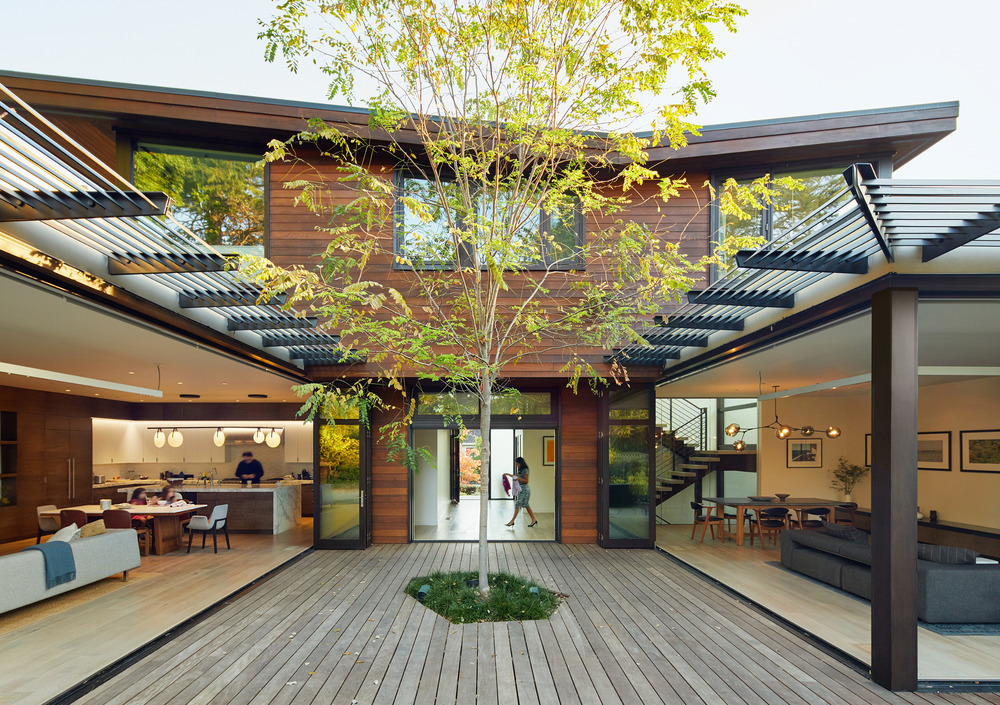Discover 8 modern inner courtyard design ideas for contemporary homes. From natural lighting and ventilation to water features and flexible layouts that enhance comfort and aesthetics.
In modern residential architecture, the inner courtyard has become one of the most popular design features. Its presence is interpreted as a response to the lifestyle needs of contemporary living.

An inner courtyard is not just decorative. It provides multiple benefits, from improving natural lighting and ventilation, enhancing energy efficiency, to offering a private space for relaxation. No wonder more architects and interior designers are reintroducing courtyards as a key element in modern home design.
Below are eight modern inner courtyard design ideas with detailed insights on their functions, benefits, and inspirations for contemporary living.
1. Maximize Natural Lighting

One of the main advantages of an inner courtyard is its ability to bring natural light into the deepest areas of a home. This creates a vibrant atmosphere while reducing energy use.
• Applications: full glass walls, sliding transparent doors, or skylights above the courtyard.
• Benefits: less reliance on artificial lighting during the day, a brighter interior mood, and improved psychological well-being.
• Example: a small courtyard surrounded by glass walls, allowing natural light to flow into the living room, dining area, and bedrooms.
2. Improve Air Circulation

Cross ventilation is often difficult in urban homes with limited land. An inner courtyard provides a natural solution for airflow.
• Applications: vertical openings, wooden or steel lattice panels, and high-level vents to optimize air movement.
• Benefits: cooler indoor temperatures, reduced reliance on air conditioning, and a healthier living environment.
• Extra inspiration: adding a small tree or a shallow pond to enhance the natural cooling effect.
3. Create the Illusion of a Larger Space

Small homes often feel cramped. A centrally placed courtyard creates a strong visual connection between indoor and outdoor spaces, making rooms appear more expansive.
• Applications: floor-to-ceiling glass, reflective surfaces, and open-plan layouts.
• Benefits: compact homes feel airy and spacious while still maintaining privacy.
• Example: a minimalist two-story urban home with a tiny courtyard featuring a single tree visible from almost every main room
4. Relaxation and Social Hub

Beyond function, a courtyard can be transformed into a versatile space for leisure and gatherings.
• Applications: weather-resistant furniture, lounge chairs, hammocks, or even a small barbecue corner.
• Benefits: serves as an extension of the living room, a simple healing space, or a private hangout spot.
• Inspiration: a courtyard designed for morning yoga, meditation, or as a children’s play zone with synthetic grass.
5. Enhance Home Aesthetics

A courtyard is more than an open space—it becomes the focal point of the home.
• Applications: Zen gardens with gravel, bonsai trees as a centerpiece, or vertical gardens for narrow areas.
• Benefits: brings calming visual aesthetics while reinforcing the overall identity of the house.
• Extra inspiration: night lighting such as in-ground lamps or tree spotlights to keep the courtyard beautiful after sunset.
6. Energy-Efficient and Eco-Friendly

By combining natural light and airflow, courtyards contribute to sustainable living.
• Applications: rainwater harvesting, planting native species adapted to the local climate, and eco-friendly hardscape materials.
• Benefits: reduced energy bills, lower carbon footprint, and improved home comfort.
• Example: a courtyard with solar panels integrated into a glass roof, blending functionality with beauty.
7. Integrating Water Features

Water is a timeless calming element. Small ponds, fountains, or reflecting pools elevate the quality of a courtyard.
• Applications: shallow stone ponds, minimalist wall fountains, or reflecting pools with aquatic plants.
• Benefits: cooling effect, soothing sound of flowing water, and a balance of natural elements.
• Inspiration: a courtyard with a koi pond surrounded by wooden decking, doubling as a relaxation space.
8. Flexible Design for Different Lifestyles

The greatest strength of a courtyard lies in its adaptability.
• Applications: a safe play area for kids, a cactus garden for busy professionals, or a stylish lounge for hosting guests.
• Benefits: tailored to different needs while still maintaining its core functions: light, air, and beauty.
• Extra inspiration: a multifunctional courtyard with a retractable glass roof, allowing use in both sunny and rainy weather.
Tips for Designing an Effective Inner Courtyard
Beyond the 8 ideas above, consider these tips to make the most out of your courtyard:
- Plan according to sun orientation – position the courtyard to capture morning light while avoiding excessive midday heat.
- Choose weather-resistant materials – such as treated wood, natural stone, or outdoor ceramic tiles.
- Maintain privacy – even as an open space, ensure the courtyard provides a sense of security.
- Integrate with key rooms – the courtyard should be visible and accessible from main living spaces like the living room, dining area, or bedrooms.
- Use low-maintenance plants – select species suitable for tropical climates to minimize upkeep.

A modern inner courtyard is more than an architectural trend—it is a timeless feature that enhances quality of life. By bringing in natural light, fresh air, and flexible design possibilities, courtyards improve comfort, efficiency, and aesthetics.
For architects, interior designers, and homeowners looking to add a contemporary yet functional touch to their projects, an inner courtyard is a design investment worth considering.

